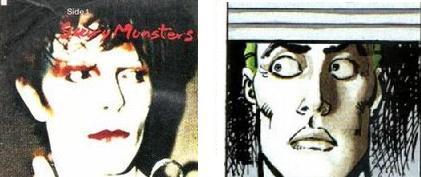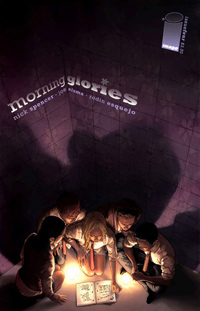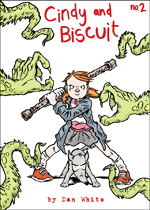
It’s unsurprising that the editors decided to pull the text above out of it’s original introductory caption box and give it’s own page in the anniversary edition of Whatever Happened to the Man of Tomorrow, transforming it into a full blown preamble.
This is what Wikipedia has to say about the closing sentence, Alan’s Moore’s last word on and celebration of Superman:
“This is an Imaginary Story… Aren’t they all?” The legend is a triple entendre:
- It could be interpreted that the story is non-canonical.
- It could be interpreted that the story is canonical, since all comic books are “imaginary stories”, so it is as valid as any “official” Superman comic
- It could be interpreted that the story is canonical, but for this incarnation of Superman, as the upcoming John Byrne reboot would render the earlier series as “imaginary”.[citation needed]
- It could be interpreted that that the story is the end of the Earth-One Superman had the Crisis on Infinite Earths never happened.
Isn’t that a quadruple entendre? Whatever. There’s something missing from that list. It’s what gives the line it’s awesome fuck yeahness, but as it doesn’t speak directly to comics it doesn’t surprise me that it often goes overlooked. Yes, Moore was quite possibly concerned that the Superman stories of his youth had just been relegated to the bin of history by Crisis on the Infinite Earths, yes he could be railing against the strictures of canon, but personally I’ve always read that line as a celebration, not just of a certain view of Superman or a certain incarnation of Superman, but of the imagination full stop.
After all, isn’t Superman, the guy who can do anything, the superhero who best encapsulates all that’s good and beautiful about the infinite possibilities of the imagination?
It’s unlikely that the Alan Moore of the mid-eighties had quite such well-formed views on the subject of meaning and story as he does today – to the best of my knowledge he didn’t talk much about Idea Space in interviews back then – but to suggest that he put great stock in fiction doesn’t strike me as much of stretch, in fact I see the line above as evidence that his thoughts were heading in the direction that would ultimately bring us From Hell and Promethea.
When Moore writes “aren’t they all” he is putting Superman stories in the same broad category as the Bible, Noddy, personal historical narratives, and the mythology of predatory paedophiles, which isn’t to say that he’s explicitly arguing that all stories are of equal importance, just that stories have the potential to be very powerful indeed, and that, hopefully, this one is amongst the best. This point is reinforced by the juxtaposition of the legend with the opening splash page featuring a memorial statue of Superman.
Memorial statues carry with them connotations of timelessness, of permanence, of stories that cannot and should not be forgotten.
Three Fools – Part 3: Morrison’s Joker
May 2nd, 2011
The third of three posts looking at stand out appearances of the Joker
Part 1 here (The Killing Joke)
Part 2 here (The Dark Knight Returns)
I. Quiet in the back row
“It’s quite possible we may actually be looking at some kind of super-sanity here. A brilliant new modification of human perception, more suited to urban life at the end of the twentieth century Unlike you and I, the Joker seems to have no control over the sensory information he’s receiving from the outside world. He can only cope with that chaotic barrage of input by going with the flow. That’s why some days he’s a mischievous clown, others a psychopathic killer. He has no real personality. He creates himself each day. He see himself as the Lord of Misrule and the world as a Theatre of the Absurd.” ~ Dr Ruth Adams, Arkham Asylum
Strangely enough we’ll need to begin this critical excavation not with a Batman comic but with Morrison’s last true commercial failure for DC. Co-authored by Marky Mark Millar and drawn by N. Steven Harris, Aztek the Ultimate Man (ably assessed by my fellow Mindless, The Beast Must Die, here) was Morrison’s first ongoing superhero gig and his only man in pants book to implode in a mere ten issues. As the sales plummeted parachuting in big draw characters like Batman and the Joker must have been as much an editorially mandated necessity as a creative choice, but Morrison made it work and gave us a glimpse of a Clown Prince that wouldn’t be fleshed out for another decade.

Three Fools – Part 2: Miller and Varley’s Joker
April 4th, 2011
The second of three post’s looking at seminal takes on the Joker. Part 1 here.
I. Super Creep

“Do you want lipstick, sweet guy?”
I was five years old when Ashes to Ashes went to number one but I vividly remember how much the video disturbed me and continued to do so right up into my teens. There’s an intensity to it that few big name promos before or since have even attempted let alone matched, and why would they? Loosely centered around Bowie’s clown and a troupe of Blitz kids dressed in high fashion’s answer to mourning dress marching along a solarised beach, followed by a bulldozer, the video has the feel of a funeral set on some faraway peninsula of David Lynch’s imagination. The overall effect is alienated, surreal and ominous, reeking of drug addiction and mental illness, and while fans will detect an air of deep introspection this does nothing to create a more comfortable space.
Coming into his teenage years and young adulthood during the 70s and 80s respectively, Miller would have been steeped in Bowie’s career and protean flight through his various personae – aesthetically driven fiction suits which the mega star inhabited both on stage and to some extent in real life – so it comes as no surprise that a writer with his sensibilities would have produced a Joker that seems to borrow, intentionally or not, from Bowie’s iconographic legacy.
Three fools – Part 1: Moore and Bolland’s Joker
March 10th, 2011
Moore and Bolland, Miller and Varley, Morrison and well… a lot of different people. Three creative teams. Three definitive takes on the Joker.
Part 2 here
Prior to The Killing Joke’s publication the Joker was ahistorical except in a strict continuity sense. Post TKJ the character had if not a definite origin, the possibility of one. A less thoughtful writer might have failed to understand the importance of keeping history at one remove from the Joker, and a less skilful one might well have struggled to introduce its shadow into the Joker’s world without anchoring the character to specifics, but it’s with his usual elegance that Moore manages to maintain some distance between the origin and its subject.

Amy Poodle vs The Comics Journal
March 6th, 2011
Finally we can bloody talk about it!

The Comics Journal’s online presence has taken a turn for the better in the form of the Comics Comics crew. Dan Nadel and Tim Holder are at the controls and the comics world is a cooler, more arty place. Good luck, fellas. Long may you reign.
But the big news? The big news is that a certain Poodle will now be blogging over there as well as over here, so if you’ve ever wondered what the guy Grant Morrison described as channelling the Invisibles actually thinks about Morrison’s magnum opus, well… check this out
Bomb light in faraway windows: the Invisibles and Hauntology
Morning Glories #1-4 reviewed
January 6th, 2011
 Nick Spencer and Joe Eisma
Nick Spencer and Joe Eisma
Late to this party but so, probably, are a lot of you.
Like the fella on the Internet says, Morning Glories is very much of the Lost school of storytelling where mystery is all. Four issues down and everything is still pretty much up for grabs at Morning Glory Academy: who are these kids? Why do they all have the same birthday? Why on Earth are the faculty terrorising them? How the heck are they going to get out? Cultists!?! Who’s gonna do it with who? Morning Glories is one big question mark that keeps getting bigger and that’s it’s primary appeal. Not to say that Nick Spencer – a writer who seemed to come out of nowhere last year but has since thoroughly stormed DC ramparts with his work on Jimmy Olsen, T.H.U.N.D.E.R Agents and Supergirl – doesn’t make the comic work in other ways, the characterisation is whedonesque in it’s clarity, the plot is multi-laced but easy to follow, and the book is surprisingly fast paced, action packed, compelling and dramatic for a title where interpersonal dynamics (i.e. talking heads) are front and centre.
Merry Christmas, humans!
December 25th, 2010
From all the Mindless Ones
xxx
Grant Morrison doc comes to London!
December 10th, 2010
Go see, London-based Mindless. Is gud. All who dwell in the Dark Dimension agree
Info here http://bit.ly/fWlGQe
If you flinch. If you shudder. You will not survive: Return of Bruce Wayne 6 – the batmanotations
November 17th, 2010

Zom: From a cave in Nanda Parbat to an old haunted house on the road out of town, and onwards to a better Batmobile. Let’s go!
Amy: Some quick preamble before we get into this. I admit to being as worried as anyone about the release dates, but that was before when the DC site made them looked really fucked up, when Batman: The Return looked like it was coming out the same week as Batman and Robin 16 or whatever it was not, and certainly never because Return of Bruce Wayne 6 was scheduled to arrive after Bruce had returned in that book. It was always obvious to me that ROBW 6 would cap Grant’s mega-story, if only because it was in that book that the real meat of the thing would have to be cleared up, dealing as the series does with Batman the myth, the eternal Batman outside of time and the linear flow of the batrob books. It was there that the spell would reach completion.
Moments before I tucked into the final issue, I discovered an old Grant Morrison JLA story in a Secret Files comic that as far as I’m aware no one I know has ever read before – the comic had been in my possession for years, but this was the first time I’d cracked it open. These kinds of weird coincidences always kick in when the deep magic is flowing.



